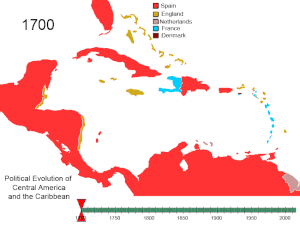History of the Americas
The history of the Americas is the history of North and South America, including Central America and the Caribbean. It begins with people migrating to these areas from Asia and possibly Oceania during the height of an Ice age. These groups are generally believed to have been isolated from peoples of the "Old World" until the coming of Europeans in the 10th and 15th centuries.
The ancestors of today's Native Americans were hunter-gatherers who migrated into North America. The most popular theory says that migrants came to the Americas via the Bering Land Bridge, Beringia, the land mass covered by the cold ocean waters in the Bering Strait. Small Paleo-Indian groups probably followed the mammoth and other prey animals. It is possible that groups of people may also have traveled into North America on shelf or sheet ice along the northern Pacific coast.


Cultural traits brought by the first immigrants later evolved and spawned such cultures as Iroquois on North America and Quechuas of South America. These cultures later developed into civilizations. In many cases, these cultures expanded at a later date than their Old World counterparts. Cultures that may be considered advanced or civilized include: Zapotec, Toltecs, Olmec, Maya, Aztecs, and the Inca.
North America
changePueblo people
changeThe Puebloan peoples of what is now the Southwestern United States and northern Mexico, living conditions were that of large stone apartment like adobe structures. They live in Arizona, New Mexico, Utah, Colorado, and possibly surrounding areas.
Chichimeca
changeChichimeca was the name that the Mexica (Aztecs) applied to a wide range of semi-nomadic peoples who inhabited the north of modern-day Mexico, and had the same sense as the European term "barbarian". The name was adopted with a negative tone by the Spaniards when they spoke of the semi-nomadic hunter-gatherer peoples of northern Mexico.
Zapotec
changeThe Zapotec emerged around 1500 years BCE. Their writing system influenced the later Olmec. They left behind the great city Monte Alban.
Olmec
changeThe Olmec civilization emerged around 1200 BCE in Mesoamerica and ended around 400 BCE. Olmec art and concepts influenced surrounding cultures after their downfall. This civilization was thought to be the first in America to develop a writing system. After the Olmecs abandoned their cities for unknown reasons, the Maya, Zapotec and Teotihuacan arose.
Maya
changeMaya history spans 3,000 years. The Maya may have collapsed due to changing climate in the end of the 10th century.
Toltec
changeThe Toltec were a nomadic people, dating from the 10th - 12th century, whose language was also spoken by the Aztecs.
Teotihuacan
changeTeotihuacan (4th century BCE - 7/8th century CE) was both a city, and an empire of the same name, which, at its zenith between 150 and the 5th century, covered most of Mesoamerica.
Aztec
changeThe Aztec having started to build their empire around 14th century found their civilization abruptly ended by the Spanish conquistadors. They lived in Mesoamerica, and surrounding lands. Their capital city Tenochtitlan was one of the largest cities of all time.
South America
changeNorte Chico
changeThe oldest known civilization of the Americas was established in the Norte Chico region of modern Peru. Complex society emerged in the group of coastal valleys, between 3000 and 1800 BCE. The Quipu, a distinctive recording device among Andean civilizations, apparently dates from the era of Norte Chico.
Chavín
changeThe Chavín established a trade network and developed agriculture by as early as (or late compared to the Old World) 900 BCE according to some estimates and archaeological finds. Artifacts were found at a site called Chavín in modern Peru at an elevation of 3,177 meters. Chavín civilization spanned from 900 BCE to 300 BCE.
Inca
changeHolding their capital at the great city of Cusco, the Inca civilization dominated the Andes region from 1438 to 1533. Known as Tahuantinsuyu, or "the land of the four regions," in Quechua, the Inca culture was highly distinct and developed. Cities were built with precisely matched stonework, constructed over many levels of mountain terrain. Terrace farming was a useful form of agriculture. There is evidence of excellent metalwork and even successful brain surgery in Inca civilization.
Present situation
changeThe number of Native Americans is increasing now in the U.S. by actual population growth, changing enrollment laws, and from the immigration from Spanish America, especially from Mexico, though the definitions being applied to them are Hispanic or Latino.
Effects of slavery
changeSlavery has had a significant role in the economic development the New World after the colonization of the Americas by the Europeans. Slaves helped build the roads upon which they were transported. The cotton, tobacco, and sugar cane harvested by slaves became important exports for the United States and the Caribbean countries.
Related pages
changeReferences
change- Kane, Katie Nits Make Lice: Drogheda, Sand Creek, and the Poetics of Colonial Extermination Cultural Critique, No. 42 (Spring, 1999), pp. 81–103 doi:10.2307/1354592
- Churchill, Ward A Little Matter of Genocide 1997 City Lights Books ISBN 0-87286-323-9